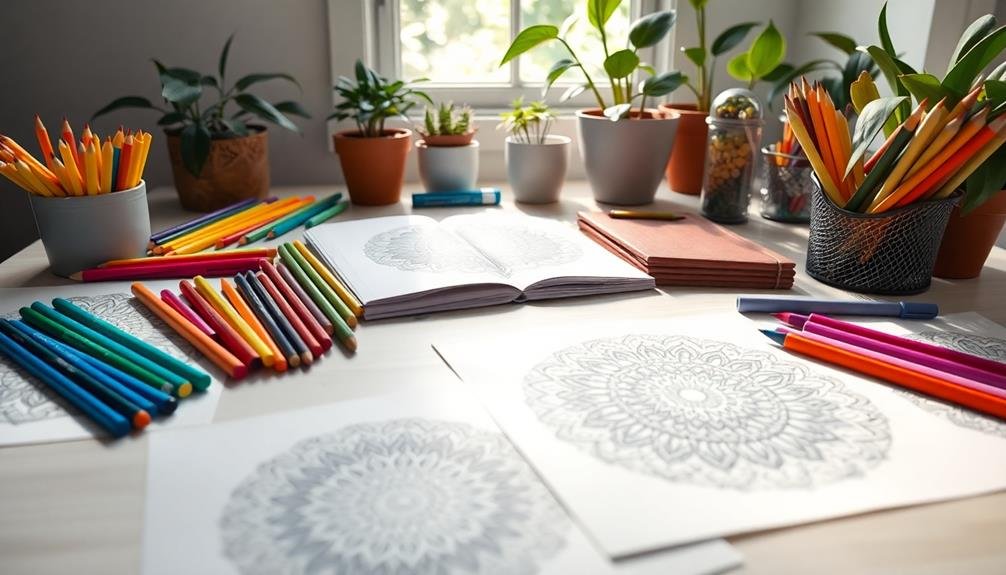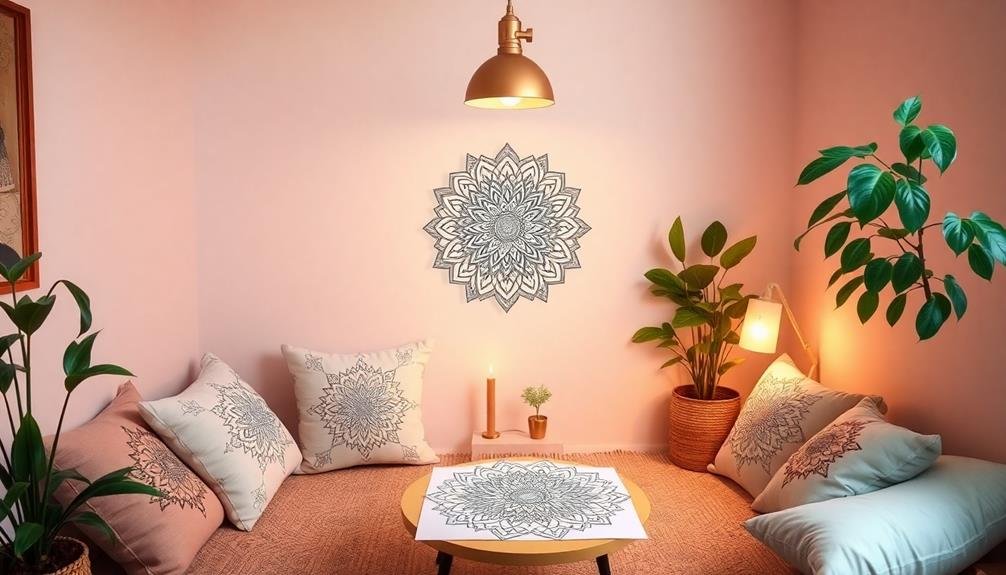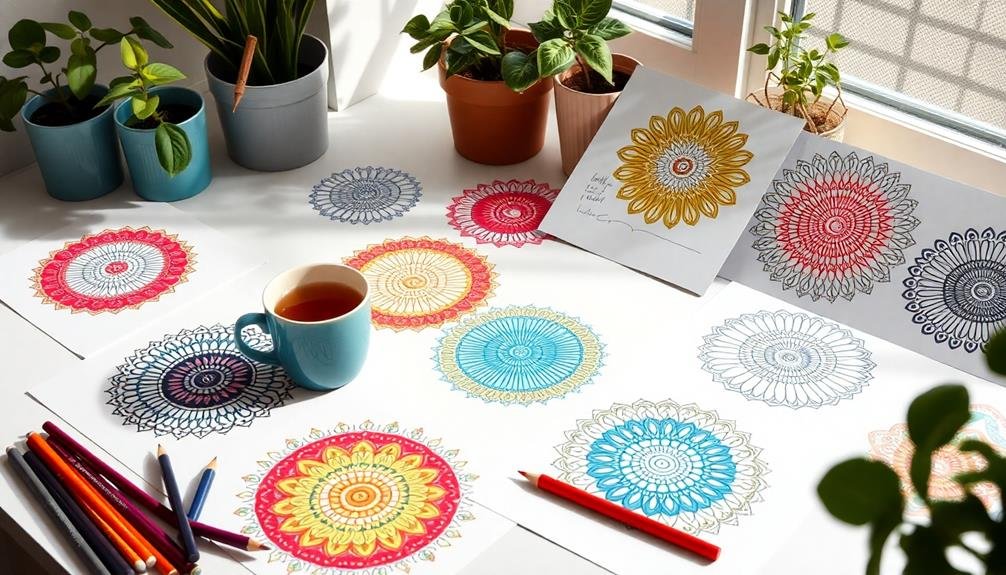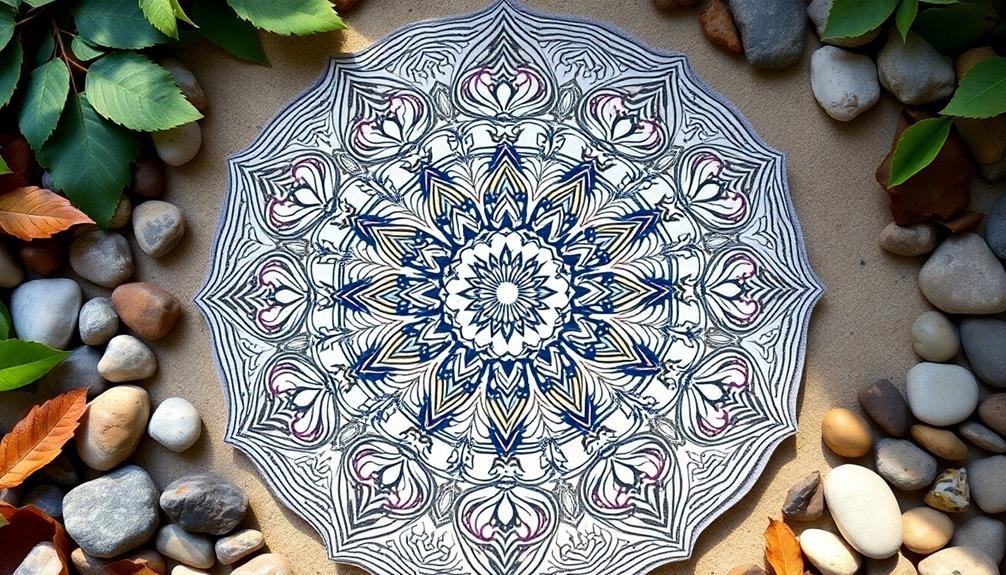Mindful coloring is a fantastic way to reduce stress and ignite your creativity. Start by choosing the right tools and a coloring book that resonates with you. Opt for calming color palettes like soft blues and greens. Create a relaxed environment by minimizing distractions and ensuring good lighting. Incorporate deep breathing to stay present, and embrace any mistakes as part of your journey. Set a time limit for your sessions to enhance focus, and explore intricate patterns for deeper immersion. There's so much more to discover about enriching your coloring experience and enhancing your relaxation techniques.
Choosing the Right Coloring Tools

When it comes to mindful coloring, selecting the right tools can make all the difference in your experience. Start by choosing a coloring book that resonates with you. Look for designs that inspire creativity and relaxation, whether they're intricate mandalas or simple nature scenes. A quality book can elevate your coloring journey.
Next, consider your coloring mediums. Colored pencils are a popular choice for their precision and ease of blending. Opt for a set that includes various shades to give you versatility. Markers, on the other hand, provide bold, vibrant colors and can add a different dimension to your artwork. Just make certain they don't bleed through the pages!
Don't overlook the importance of paper. Thicker paper prevents bleed-through and allows for smoother strokes. If possible, test your tools on a separate sheet to verify they work well together.
Selecting Calming Color Palettes
To create a soothing atmosphere while coloring, selecting calming color palettes is essential. You'll want to choose colors that evoke tranquility and relaxation. Soft hues like blues, greens, and pastels can help promote a sense of peace. Think about the emotions you want to feel during your coloring session, as this can guide your palette selection.
Here's a simple guide to some calming color combinations:
| Color 1 | Color 2 | Color 3 |
|---|---|---|
| Light Blue | Soft Green | Pale Yellow |
| Lavender | Mint Green | Cream |
| Sky Blue | Peach | Light Gray |
When you experiment with these palettes, notice how they make you feel. You might find that certain combinations resonate with your mood more than others. Remember, there's no right or wrong choice—just what feels best for you. By focusing on calming colors, you'll enhance your coloring experience and create a serene environment that encourages mindfulness and relaxation. So grab your coloring tools and let those soothing shades flow!
Creating a Relaxing Environment

To truly enjoy your mindful coloring experience, find a comfortable space where you can sit and focus.
Make sure to minimize distractions around you, whether that means silencing your phone or choosing a quiet corner of your home.
Creating this peaceful environment will help you fully immerse yourself in the process.
Choose a Comfortable Space
Finding the right environment can greatly enhance your mindful coloring experience. Start by choosing a space that feels inviting and comfortable.
Whether it's a cozy nook in your living room or a sunlit spot on your balcony, make sure you can settle in without feeling cramped. You want to create a space that encourages relaxation, so consider the seating. A supportive chair or a soft cushion can make all the difference.
Lighting plays a vital role too. Natural light is ideal, but if that's not possible, use soft, warm lamps to avoid harsh glare. This will help you focus on the colors and patterns without straining your eyes.
Surround yourself with items that inspire calmness, like plants or soothing artwork, to further enhance the ambiance.
Minimize Distractions Around You
Creating a calming atmosphere isn't just about the space itself; it's also about minimizing distractions. To get the most out of your mindful coloring experience, start by eliminating any potential interruptions. Turn off your phone or switch it to silent mode. If you're at home, let others know you need some quiet time to focus on your art.
Next, consider your surroundings. Tidy up your workspace so it feels inviting and organized. Clutter can create mental noise, making it hard to concentrate. Dimming the lights or playing soft instrumental music can also help set a tranquil mood.
Pay attention to your sensory environment. If certain smells calm you, light a scented candle or use essential oils. Make sure the temperature is comfortable; you don't want to be too hot or too cold while you color.
Lastly, be mindful of your internal distractions. Take a few deep breaths before you begin to clear your mind. Focus on the rhythm of your breath to help ground yourself.
Practicing Deep Breathing Techniques
As you immerse yourself in mindful coloring, incorporating deep breathing techniques can enhance your experience and help you relax. Start by finding a comfortable position, whether seated or standing. Close your eyes and take a moment to focus on your breath. Inhale deeply through your nose, allowing your abdomen to expand fully. Hold that breath for a few seconds, then exhale slowly through your mouth. Repeat this cycle a few times until you feel a sense of calm.
Once you've settled into your breathing, begin to add it to your coloring practice. With each stroke of your pencil or marker, synchronize your breath. Inhale deeply as you start a new section, and exhale slowly as you fill it in. This rhythmic approach not only grounds your focus but also helps clear your mind of distractions.
If you feel tension creeping in, pause your coloring and return to your breath. A few intentional breaths can reset your mindset.
Embracing Imperfection in Art

Embracing imperfection in art is a powerful way to liberate your creativity and deepen your connection to the coloring process. When you let go of the need for perfection, you open yourself up to new experiences and self-expression.
Here are some ways to embrace the beauty of imperfection:
- Celebrate mistakes: Instead of erasing, turn those errors into unique elements of your artwork.
- Use unconventional colors: Don't be afraid to color outside the lines—literally! Experiment with unexpected color choices to give your piece personality.
- Practice self-compassion: Remind yourself that art is a journey, not a destination. Be kind to yourself as you navigate this process.
- Enjoy the process: Focus on the act of coloring rather than the final product. Relish each stroke and let it be a form of meditation.
Setting a Time Limit
Setting a time limit for your coloring session can enhance your focus and help you stay present in the moment.
By choosing a specific duration, you can maximize the benefits of mindful coloring while minimizing distractions.
You'll find that this practice not only boosts your creativity but also fosters a sense of accomplishment.
Benefits of Time Limits
Time limits can transform your coloring experience into a focused and fulfilling practice. By setting a specific timeframe for your sessions, you can enhance your creativity and mindfulness. Here are a few benefits you'll notice:
- Increased Focus: With a set time, you'll find it easier to concentrate on your artwork, minimizing distractions.
- Enhanced Creativity: A deadline can push you to think outside the box and explore new techniques or color combinations you mightn't have considered otherwise.
- Stress Reduction: Knowing you have a limited time can alleviate the pressure to create a masterpiece, allowing you to enjoy the process without overthinking it.
- Improved Satisfaction: Completing a coloring piece within your time limit can give you a sense of accomplishment, boosting your mood and encouraging you to continue.
Incorporating time limits into your coloring sessions can promote a healthier mindset. You'll not only enjoy the act of coloring more, but you'll also cultivate a stronger sense of presence in the moment.
Choosing Your Duration
Finding the right duration for your coloring sessions can markedly impact your overall experience. Setting a specific time limit helps create a structured yet relaxed environment.
Start by considering your daily schedule and energy levels. If you're a busy person, you might find that 20 to 30 minutes is ideal. This duration allows you to engage without feeling rushed, giving you a taste of mindfulness without a significant time commitment.
On the other hand, if you have a more flexible day, you might enjoy longer sessions of up to an hour. This extra time can help you explore deeper into your creativity and fully immerse yourself in the process. However, be cautious not to overextend; too long might lead to fatigue or frustration.
Try experimenting with different durations to discover what feels best for you. You might find that shorter, frequent sessions work better on busy days, while longer ones might be perfect for weekends or days off.
Ultimately, the key is to find a balance that allows you to enjoy the coloring experience without feeling pressured. Aim for a duration that enhances your mindfulness, making each session enjoyable and fulfilling.
Staying Focused and Present
To stay focused and present during your coloring sessions, try breaking your time into manageable chunks. Setting a time limit can help you concentrate better and enhance your mindfulness.
Here are some tips to make the most of your coloring experience:
- Choose a specific duration: Start with 15-30 minutes to prevent fatigue and maintain your focus.
- Use a timer: Set an alarm to gently remind you when your time is up, so you can fully immerse yourself without worrying about the clock.
- Prioritize your environment: Find a quiet space free from distractions; this helps you stay engaged in the moment.
- Reflect briefly: After each session, take a moment to assess how you felt and what you accomplished. This can deepen your connection to the process.
Exploring Mindful Patterns and Designs

As you explore mindful coloring, you'll discover that patterns and designs play an essential role in enhancing your experience. Choosing intricate patterns can draw you in, allowing you to focus on the details and immerse yourself fully in the moment. Whether it's mandalas, floral designs, or geometric shapes, each offers a unique opportunity to express your creativity.
When you engage with these designs, try to let your mind wander less and concentrate more on the process. Notice how each stroke of your coloring tool interacts with the pattern. As you fill in the spaces, pay attention to the colors you choose and how they make you feel. This awareness can deepen your sense of mindfulness.
Additionally, experimenting with different styles can open up new avenues for relaxation. You might find that symmetrical patterns soothe you, while chaotic designs allow for more freedom.
Don't hesitate to mix and match, creating your own unique designs. Embrace the journey of coloring, and remember that there's no right or wrong way—only your personal expression. With each pattern, you're not just coloring; you're practicing mindfulness, enhancing your overall well-being.
Frequently Asked Questions
Can Children Also Benefit From Mindful Coloring Practices?
Absolutely, children can benefit from mindful coloring practices! It helps them express emotions, enhances focus, and improves fine motor skills. You'll notice they feel calmer and more centered after engaging in this creative activity.
What Are the Best Coloring Books for Beginners?
When you're choosing coloring books, look for ones with simple designs and themes that inspire you. Popular options include mandalas, nature scenes, or abstract patterns. These will help you relax and enjoy the coloring experience.
How Often Should I Practice Mindful Coloring?
You should practice mindful coloring as often as you can. Even just a few minutes daily can help reduce stress. Find a routine that fits your schedule, and enjoy the calming benefits whenever you can.
Is There a Specific Time of Day for Coloring?
There's no specific time for coloring; it's all about what works for you. Whether it's morning, afternoon, or evening, find a time when you can relax and fully immerse yourself in the experience.
Can Digital Coloring Apps Provide the Same Benefits?
Digital coloring apps can definitely provide similar benefits. They offer convenience and a variety of colors, allowing you to express creativity. Plus, they often include calming features that help reduce stress, just like traditional coloring.
In Summary
By incorporating these mindful coloring techniques, you can transform your coloring experience into a stress-relieving escape. Remember to choose tools that feel comfortable, explore calming colors, and create a cozy space for yourself. As you color, practice deep breathing and embrace the beauty of imperfection. Set a time limit to stay focused, and let your creativity flow with mindful patterns. Enjoy the journey, and watch as your stress melts away, one stroke at a time.





Leave a Reply